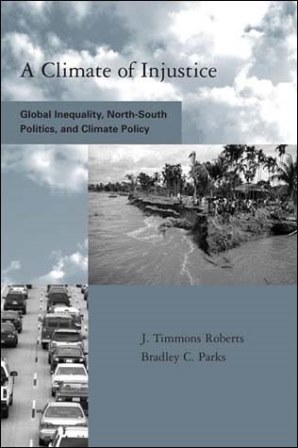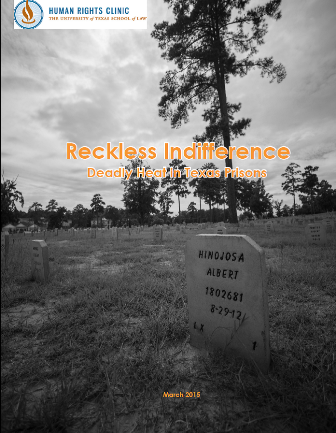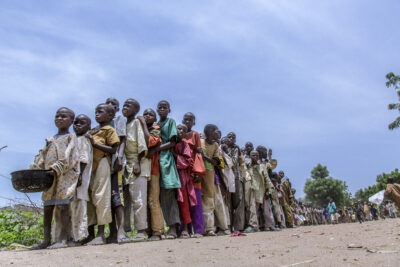Environmental injustice is a term scholars and activists use to describe the fact that environmental threats in general, and climate disruptions in particular, affect communities, nations, and regions of the globe unevenly, with global South communities, people of color communities, and indigenous communities being hit the hardest.1→Robert Bullard and Beverly Wright, The Wrong Complexion for Protection: How the Government Response to Disaster Endangers African American Communities (New York University Press, 2012).
→David Ciplet, J. Timmons Roberts, and Mizan R. Khan, Power in a Warming World: The New Global Politics of Climate Change and the Remaking of Environmental Inequality (The MIT Press, 2015). These injustices in outcomes are compounded by the fact that these same communities have contributed the least to creating the problem of global ecological risks and climate change.2 The MIT Press, 2006More Info → In this essay, I link the field of environmental justice (EJ) studies to the prison-industrial complex by examining how prisons are sites of social oppression and ecological harm impacting mainly the poor and communities of color. Specifically, I demonstrate that prisons actively contribute to environmental racism and climate change through planning decisions that place ecosystems and human health at great risk.
The MIT Press, 2006More Info → In this essay, I link the field of environmental justice (EJ) studies to the prison-industrial complex by examining how prisons are sites of social oppression and ecological harm impacting mainly the poor and communities of color. Specifically, I demonstrate that prisons actively contribute to environmental racism and climate change through planning decisions that place ecosystems and human health at great risk.
Prisons as sites of environmental injustice
EJ scholarship and politics address critical threats and challenges faced by residents and activists in vulnerable communities, and the list of concerns is continually expanding in new directions. For example, it is now clear there are numerous ways that prisons and environmental threats intersect to produce harms to the bodies of prisoners and corrections officers as well as to nearby ecosystems and their inhabitants.3See David N. Pellow, What Is Critical Environmental Justice? (Polity Press, 2017) and Prison Ecology Project, “Examples of Prison Pollution and Environmental Justice Issues in U.S. Prisons” (Lake Worth, Florida: PEP, 2016).
The following is just a sampling: (1) there are confirmed reports of water contaminated with arsenic, lead, and other pollutants at prisons in nearly 20 US states, including the now-infamous case of Flint, Michigan, where the Genesee County Jail’s inmates—including pregnant women—were forced to drink toxic water while prison guards drank filtered water; (2) the Rikers Island jail in New York City was built atop a landfill that for years has produced methane gas explosions and is plagued with health complaints from cancer-stricken corrections officers; (3) the Victorville Federal Correctional Complex in California was built on a former nuclear weapons storage area (WSA) and is now a federally designated toxic military Superfund site; (4) the Northwest Detention Center in the Seattle-Tacoma area is a privately-operated prison designed to house more than 1,500 immigrant detainees and is built adjacent to a federally designated toxic Superfund site; (5) prisoners across many states recycle hazardous electronic waste for very low wages and enjoy few, if any, health and safety protections;4Sarah Conrad, “A Restorative Environmental Justice for Prison E-Waste Recycling,” Peace Review 23, no. 3 (September 2011): 348–355. (6) Texas prisoners face some of the worst heat and humidity of any inmates in the nation, because of extreme weather combined with a lack of air conditioning and deficient medical care at facilities throughout the state. A recent investigation concluded that 14 prisoners died between 2007 and 2014 due to extreme heat and neglect by the Texas Department of Criminal Justice.5 Human Rights Clinic; Austin, Texas: University of Texas School of Law, 2015More Info →
Human Rights Clinic; Austin, Texas: University of Texas School of Law, 2015More Info →
The impacts of prisons outside their walls are also profound. Sewage overflows, chemical toxins, fossil fuel emissions, air pollution, and hazardous waste generated from inside many prisons affect ecosystems, nonhuman and human species, and communities, as they also impact waterways, ambient air, and nearby land bases. Between 2006 and 2014, the Monroe Correctional facility (just north of Seattle) dumped a half million gallons of sewage into the Skykomish River, a popular recreational and fishing spot for people in the region. In another case, the proposed prison in Letcher County, Kentucky, is to be built on a mountaintop removal coal mining site near a low-income community, a facility that threatens at least 71 nonhuman species, many of them endangered (including the Indiana bat and the grey bat).6The fact that these nonhuman species and ecosystems are more vulnerable via the prison system speaks to the ways that human and nonhuman communities are linked through what David Nibert calls “entanglements of oppression.” Communities are entangled within and across species in ways that reveal how the scholarship on environmental inequality and intersectionality can benefit from extending beyond the restrictive boundaries of the human to encompass and observe the modes through which humans and nonhumans are connected through discourses, policies, and practices of oppression and privilege making. See David Nibert, Animal Rights/Human Rights: Entanglements of Oppression and Liberation (Rowman and Littlefield, 2002). Since the US prison system is overwhelmingly made up of people who are poor and nonwhite, these environmental risks fall disproportionately on these populations, compounding the vulnerability and marginalization they already experience through a myriad of other social, political, and economic forces.
Two campaigns and an opportunity for collaboration
One potential way to highlight the prison-industrial complex’s role in environmental injustice has emerged within the University of California system, if two groups might consider working together. Fossil Free UC is a campaign led by students, faculty, staff, and alumni from the ten-campus University of California system that works to raise awareness of the hazards of the fossil fuel economy, to urge the UC system to divest from fossil fuels, and allocate its investments with greater attention to climate risk and social responsibility.
“Four UC chancellors endorsed their cause and students are continuing to work toward securing an agreement from the UC regents to achieve their goal.”The Fossil Free UC campaign has had major successes since its inception in 2012. In September 2015, the UC system agreed to sell off its endowment and pension fund holdings in oil sands and coal companies—a decision worth $200 million. However, divesting from tar/oil sands and coal still left traditional (non-tar sands) oil and natural gas investments untouched, so many Fossil Free UC student activists have taken up the call to “divest the rest!” Four UC chancellors endorsed their cause and students are continuing to work toward securing an agreement from the UC regents to achieve their goal.
In December 2015, just three months after Fossil Free UC achieved its first divestment success, the Afrikan Black Coalition (ABC)—a UC-wide campaign led by Black students concerned with drawing attention to and confronting the ways in which that university system’s policies affect Black students and people throughout the African diaspora—succeeded in pushing the UC system to divest $25 million from private prisons. This divestment was prompted by concerns about the UC system’s relationship to private prisons and to those who finance that industry, because of the disproportionate number of people of African descent who are incarcerated in such facilities. The Afrikan Black Coalition pushed even further in announcing an additional demand that the UC must divest $425 million from Wells Fargo Bank. It called for this action because of the bank’s “discriminatory lending practices in Black and brown neighborhoods”; its role as a syndication agent and issuing lender for CoreCivic (formerly Corrections Corporation of America, a private prison company); its status as a trustee to the GEO Group (the largest private prison company in the United States); and its membership in the Million Shares Club, a group of investors with at least one million shares in CoreCivic and the GEO Group—all of which meant “effectively financing the dehumanization of Black and migrant people.”
In both the Fossil Free UC and Afrikan Black Coalition campaigns we see a number of similarities and parallels: both groups are statewide, multi-university coalitions willing to take direct action to achieve progressive goals that exposed links between educational institutions and oppressive investment practices; they have achieved major successes through divestment campaigns that reorganized power dynamics between the UC regents and students; and both groups have declared their intentions to push further for more comprehensive changes.
However, it appears there is no clear effort on the part of these two groups to work together and to link the divestment from fossil fuels to the divestment from prisons. In other words, the UC system is invested in both the fossil fuel and prison industries, both of which perpetrate environmental injustices. Why not link these campaigns? Activists and scholars can document and articulate the links between universities and prisons around the goals of racial and environmental justice because universities, prisons, banks, and the fossil fuel industry are frequent contributors to various forms of social oppression and ecological harm.
Conclusion
“The environmental justice movement has long been an exemplar of this type of complex effort to create social change.”Multi-issue, intersectional social movement campaigns are among the most generative, inclusive, and invigorating forms of grassroots activism in the twenty-first century, and the environmental justice movement has long been an exemplar of this type of complex effort to create social change. Environmental justice activists and scholars have, for example, done important work by expanding and deepening the ways we define what counts as an “environmental” concern to extend beyond “wild” spaces (forests, rivers, mountains, and their associated flora and fauna) typically associated with white middle-class environmentalism to include urban and rural terrains where working-class people and people of color live, work, play, learn, and (sometimes) pray.
What this also means is that EJ scholars and advocates have broadened the category of “environmentalist” to include a much greater swath of people who—according to compelling survey evidence—are generally just as committed (if not more) to the protection of our ecosystems as anyone else, but who also frequently articulate environmental concerns in terms that are linked to public health and the preservation of livelihoods and places of deep cultural significance. Prisons are a site where many of these concerns converge, since ecosystem health and public health are often threatened by their construction and daily operations, and because they are spaces where race, class, and gender inequalities are on full display, but only if we are paying attention.
References:
→David Ciplet, J. Timmons Roberts, and Mizan R. Khan, Power in a Warming World: The New Global Politics of Climate Change and the Remaking of Environmental Inequality (The MIT Press, 2015).














